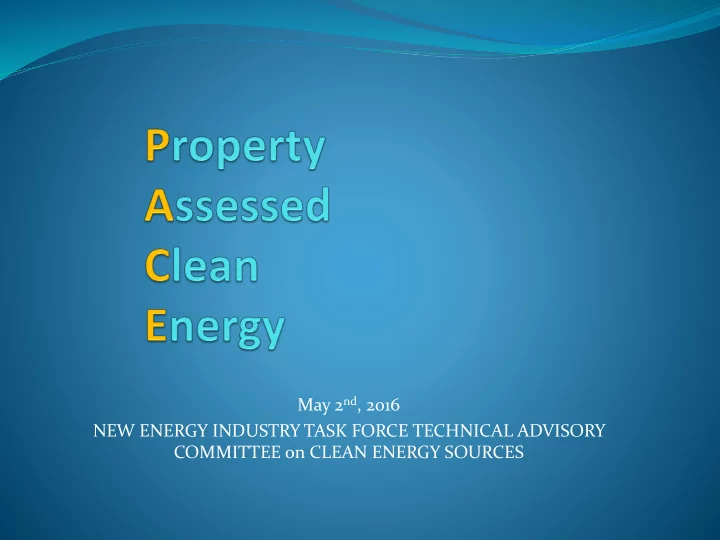

May 2 nd , 2016 NEW ENERGY INDUSTRY TASK FORCE TECHNICAL ADVISORY COMMITTEE on CLEAN ENERGY SOURCES
Summary PACE Introduction Key Details Past and New – Forms of Security Government Involvement Logistics of a PACE Program Complement to Future Efforts Economic Benefits Proposed Legislation
PACE Introduction WHAT: PACE is P roperty A ssessed C lean E nergy finance program Energy efficiency improvements Renewable energy installations HOW: Provides a method of financing Uses Special Improvement District statute to attach a lien to the property that is superior to a mortgage WHY: Satisfies the need for long term financing for interested commercial property owners Energy improvement projects often have longer payback periods Repayment transfers to new owner if property is sold Is a scalable and off balance sheet
PACE Introduction States with PACE-enabling legislation: 32 plus D.C. States with active PACE programs: 16 PACE Programs in operation: 35 Commercial financing (2009-2015) $93 million Residential financing (2009-Current) $1.69 billion on 82,000 homes $230 million on 734 commercial buildings Funding by type: 48% Energy Efficiency 39% Renewable Energy 14% Mixed (source: www.pacenow.org)
Key Details – Public Impact PACE can not be used for public projects Municipality can not back the debt There is no practical exposure to the debt rating of: The local municipalities involved in PACE directly The State or any other municipal entity Property is explicitly private not public Public procurement laws are not applicable
Forms of Security for the Loan Other PACE programs around the country are backed by municipalities Lenders are providing capital to those programs based on the security provided by the municipality Last year loans provided solely on the lien to value ratio!! Lenders don’t ask to see the financial reports of the commercial property owner – scalable PACE does not overly restrict the municipality from creating a program and allows for different underwriting standards to be utilized
Government Involvement In order for the lien to be attached to a property in a superior position to existing mortgages legislation is required For debt to be issued under NRS 271 the municipality must acknowledge and authorize the issuance of debt Limited to conduit issuance role Debt rating not in jeopardy City of Las Vegas reports no delinquencies in $88 million in outstanding developer backed SID debt The billing and collection of debt payments can be outsourced by the municipality Any costs that the municipality can identify may be recaptured in the program
Logistics of a PACE Program Municipality could designate their entire entity an Energy Improvement District (EID instead of SID) Municipality would have to identify some program parameters: Is there an existing non-profit entity that can administer the program Identify commercial participants Identify auditors and contractors Provide information and documentation to governing body of the municipality One model will provide a template for others When projects reach the point where construction may begin the municipality would issue a bond or warrant repaid solely by proceeds from the projects Liens get recorded Debt service collection process determined (similar to SIDs)
Logistics of a PACE Program In the event of a default the unpaid assessment simply accrues on the property, with interest and penalties Lender will be repaid when a new owner takes over the property Payment of an uncollected assessment is similar to payment of unpaid taxes When the debt is paid off the property simply leaves the assessment district (Energy Improvement District)
Complement to Future Efforts The ability to attach a lien to the property can be used with other incentives Federal tax credits for solar Utility incentives State or local government incentives – strong interest by municipalities in NV Grants Existing financing programs through the Governor’s Office of Energy Complements Green Bank efforts currently being researched by the Governor’s Office of Energy
Economic Benefits of Energy Projects RCG Economics of Las Vegas, NV (John Restrepo) was commissioned to look into the benefits of energy improvements including PACE financing Total Economic benefits include: Direct Benefits – one time investment in construction Indirect Benefits – wholesale purchases Induced Benefits – goods and services purchased by employees Multiplier for energy improvements estimated to be 1.56 Number of jobs created by energy improvements are 41% greater than jobs created from non-energy efficiency related spending
Additional Benefits of Energy Projects Reducing utility expenses leads to greater profitability Increased property values Job growth in the local economy Improved occupant health and productivity Provides a long term solution for a long term project Demonstrates leadership Larger environmental benefits
Proposed Legislation – (SB 250 from 2013) Amends NRS 271 Each participant consents in writing (each property owner participates voluntarily) Page 2 line 5 Property may not be “underwater” Page 2 lines 33-39 Liens must be recorded Page 2 lines 40-45 Nevada contractors must be used Page 3 line 12 Must be private property Page 3 lines 31-34
Proposed Legislation – (SB 250 from 2013) Amends NRS 271 Gives municipality the ability to determine procedures Page 3 lines 38-41 then (a) through (j) Debt is not backed by the municipality Page 4 lines 41-44 Proof of payment to contractor is required Page 6 lines 25-45 onto Page 7 lines 1-5
Conclusion SB 250 from 2013 session There is strong support from local municipalities Strong statewide industry support Focus of Governor’s Office of Energy There are many Nevada-based interests that are interested in this bill and in its passage
Questions? tfarkas@ameresco.com
Recommend
More recommend